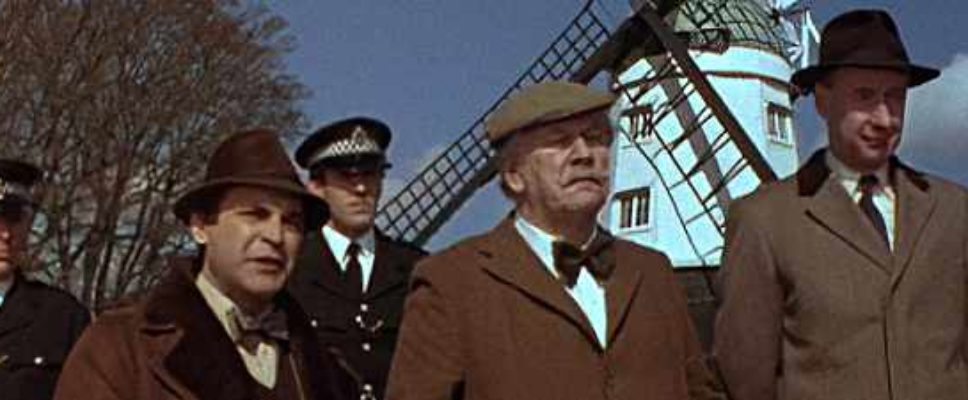Teresa reviews “Thirteen at Dinner” (1985)
Teresa reviews “Thirteen at Dinner” (1985) and loved seeing David Suchet before he put on the mustache.
Fidelity to text: 4 knives
![]() It’s really close to the novel. The major change is to the date, the minor ones add a film within a film and remove why murder was preferred to divorce.
It’s really close to the novel. The major change is to the date, the minor ones add a film within a film and remove why murder was preferred to divorce.
Quality of movie on its own: 4 knives
![]()
![]()
![]()
Read more of Teresa’s Agatha Christie movie reviews at Peschel Press.
Also, follow Teresa’s discussion of these movies on her podcast.

The oddest part of this film is the date change. Peter Ustinov’s two previous outings as Poirot were Death on the Nile and Evil Under the Sun. Both were 1930s period pieces down to the last detail of clothes, hair, and cars. They were also feature films. Thirteen at Dinner was filmed for television, meaning a much smaller budget. It became a contemporary; massive savings on wardrobe and sets paid for an all-star cast and a tour of London.
Poirot’s wardrobe is still exquisitely tailored, but it’s more in keeping with the 1980s. In addition, the film opened with a scene that should have been jarring but instead anchored the film in the modern-day. Thus, Hercule Poirot is interviewed by David Frost.
Many of you may not remember Frost (1939–2013). He was a major TV personality and journalist. He hosted a talk show where he interviewed everybody who was anybody— including eight British Prime Ministers and seven U.S. presidents.
If you were in the spotlight, you had a good shot at chatting with David Frost. It would be natural for the world’s greatest detective to appear on David Frost. The TV talk show format also neatly introduced Bryan Martin (movie star), Carlotta Adams (impersonator), and Jane Wilkinson (movie star) to Poirot and to the audience.


Agatha played fast and loose with the mystery conventions in Thirteen at Dinner (which was the U.S. title for the novel; in Britain it was Lord Edgware Dies). Watch Jane Wilkinson closely and listen to what everyone says about her. Faye Dunaway did a great job as Jane and her impersonator Carlotta Adams. Jane is amoral, selfish, narcissistic, poorly educated, and everyone who knows her agrees that she’s definitely capable of murder. Carlotta Adams, by contrast, is funny, friendly, well-educated, and everyone agrees that she’s a wonderful person.
You know what a setup like this means. No matter what happens, Jane couldn’t possibly knife her hated husband: It’s too obvious! It must be Carlotta Adams, because she’s so unlikely. Yet at the same time, who is the most likely candidate for murdering a spouse? Every policeman in the universe will tell you. Thus, the conundrum at the heart of Thirteen at Dinner. It’s impossible for Jane Wilkinson to stab Lord Edgware, but there’s his body.
The film omitted the method of murder for no discernible reason. In the novel, it’s a corn knife; a specialized, razor-sharp, extremely narrow and thin-bladed folding knife used for home surgery on your feet. There’s a reason for using it for murder: it slides so easily and neatly into the back of the neck and up into the brain, resulting in instant death. No mention is made of corn knives or indeed much about how the murders were committed, other than a knife of some kind. This does keep the gore to a minimum.
The major omission in the film, the same point that was skipped in 1934’s Lord Edgware Dies, was the motive. Hollywood itself, being a bastion of hardcore atheists who have a less-than-zero understanding of religious belief, must be the reason. The producers decided that an audience would not accept or understand the motive, using the few minutes needed to explain it for shots of Bryan Martin’s movie within a movie. But why skip it? Audiences are not stupid and can understand an explanation delivered by good acting and a well-written script. Agatha provided a very good reason for murder so why not use it?
But they didn’t, so I’ll clue you in. The Duke of Merton is a devout Anglo-Catholic. He’s extremely serious about his faith. He could marry a widow but not a divorcée. If Jane Wilkinson wants to become the Duchess of Merton (over the duke’s mother’s strenuous objections, another skipped plot thread), she needs to do something about her inconvenient husband.
The film within a film was amusing, especially as you gradually got the joke: Bryan Martin (Lee Horsley) doesn’t do his own stunts.


Jonathan Cecil played a wonderful Hastings, as good as Hugh Fraser in the Poirot TV series. He appears in two more of Ustinov’s Poirot films, and I’m looking forward to them.
The actor you’re dying to know about is David Suchet. He plays Inspector Japp to Ustinov’s Poirot, giving you, dear film-goer, two Poirots for the price of one.
It’s decidedly odd to watch Suchet, sans mustache and smart morning suit, chewing up the scenery along with everything edible within range. The investigation into Lord Edgware’s murder meant no breakfast for him so if there’s food nearby, he’s wolfing it down.


Suchet claims he didn’t like his performance in this film. However, he did a good enough job that Ustinov told him that he’d make a good Poirot.


And there are boats! There’s a charming scene where Jane is jogging alongside a narrow canal. Keeping pace with her for his interview is Poirot in a small, powered dory. Hastings mans the outboard and the tiller, providing stalwart support for the master.
You’ll like this film.



